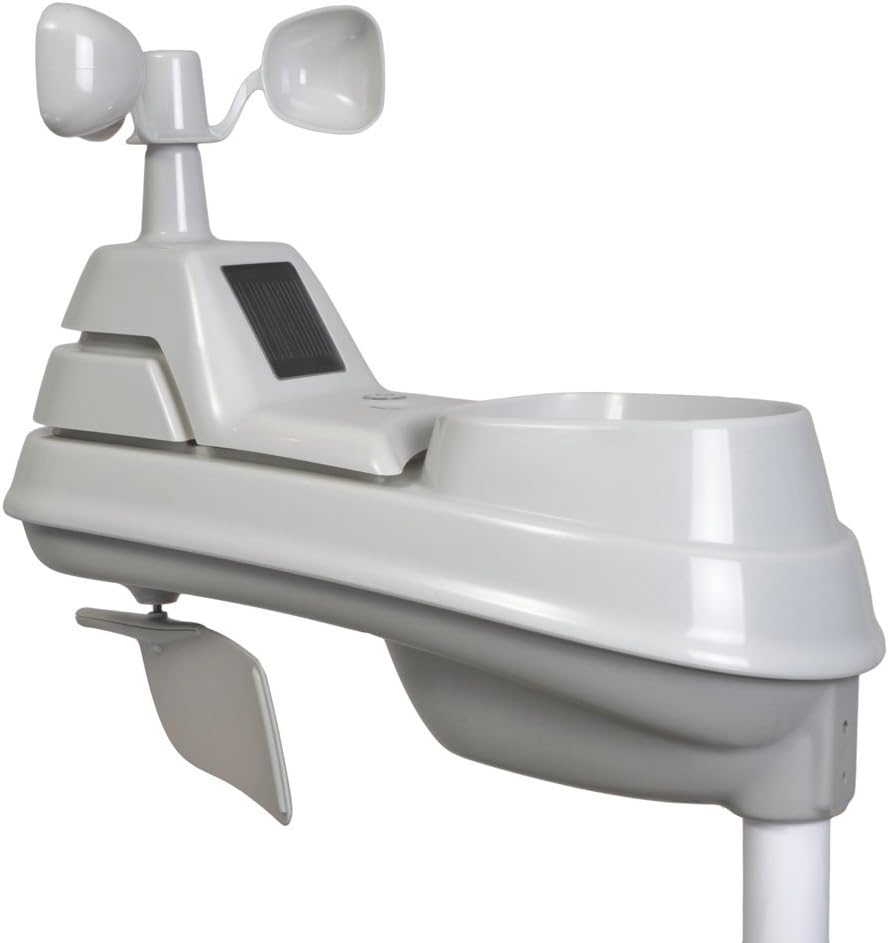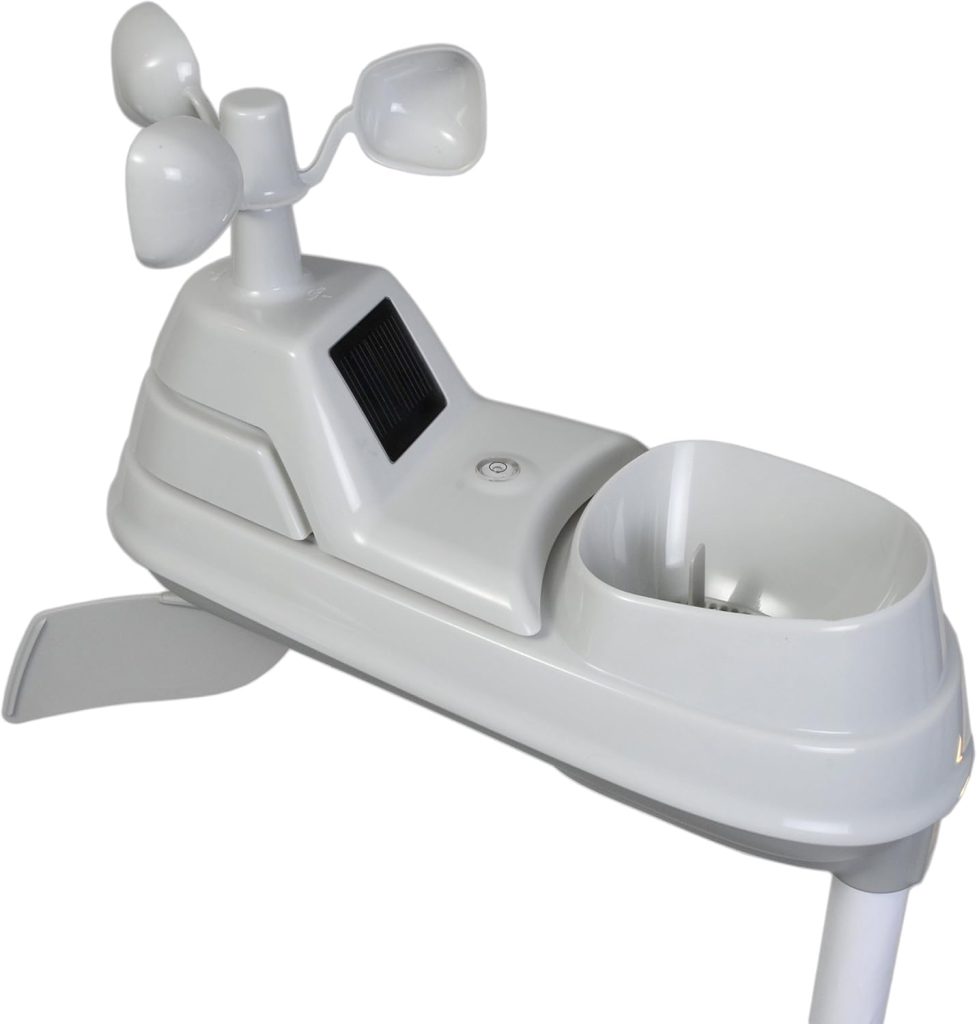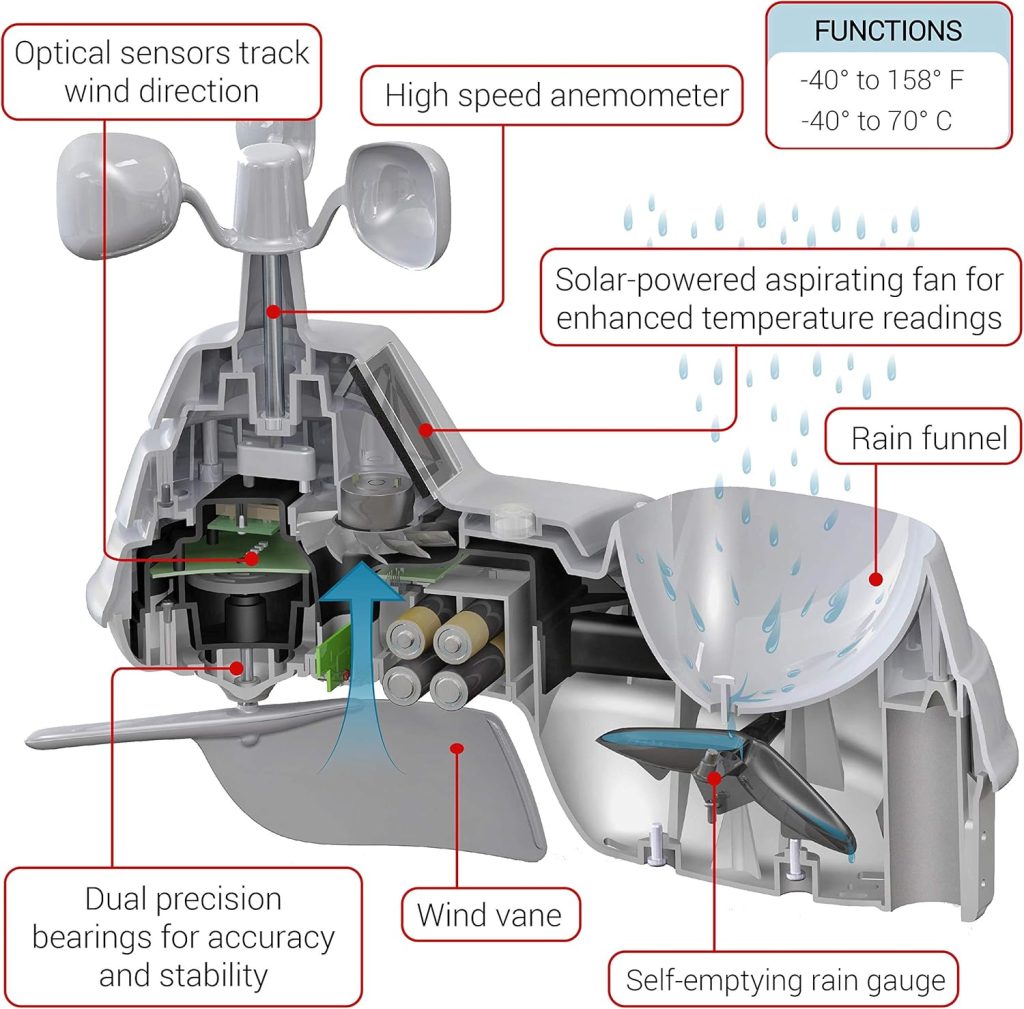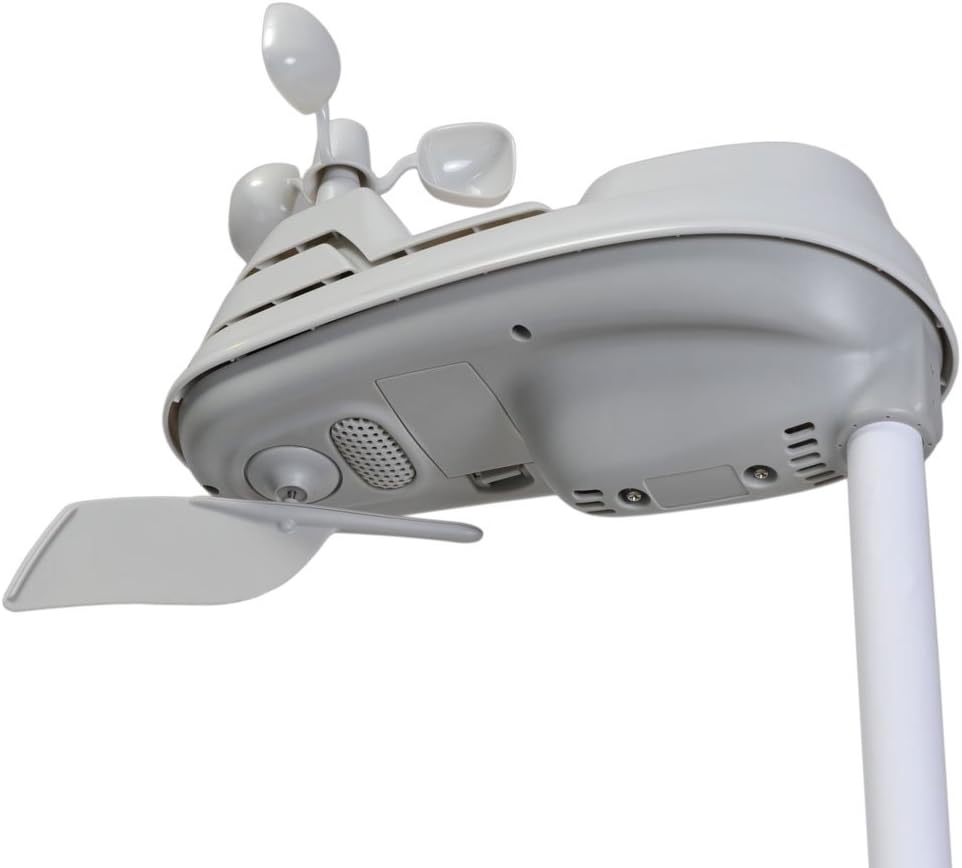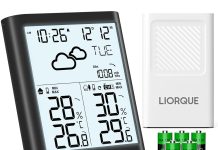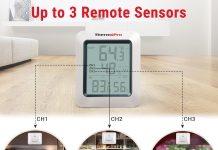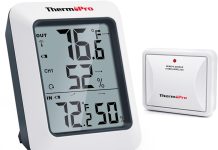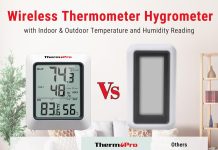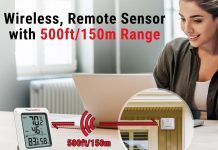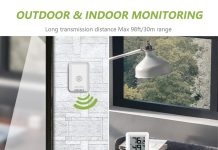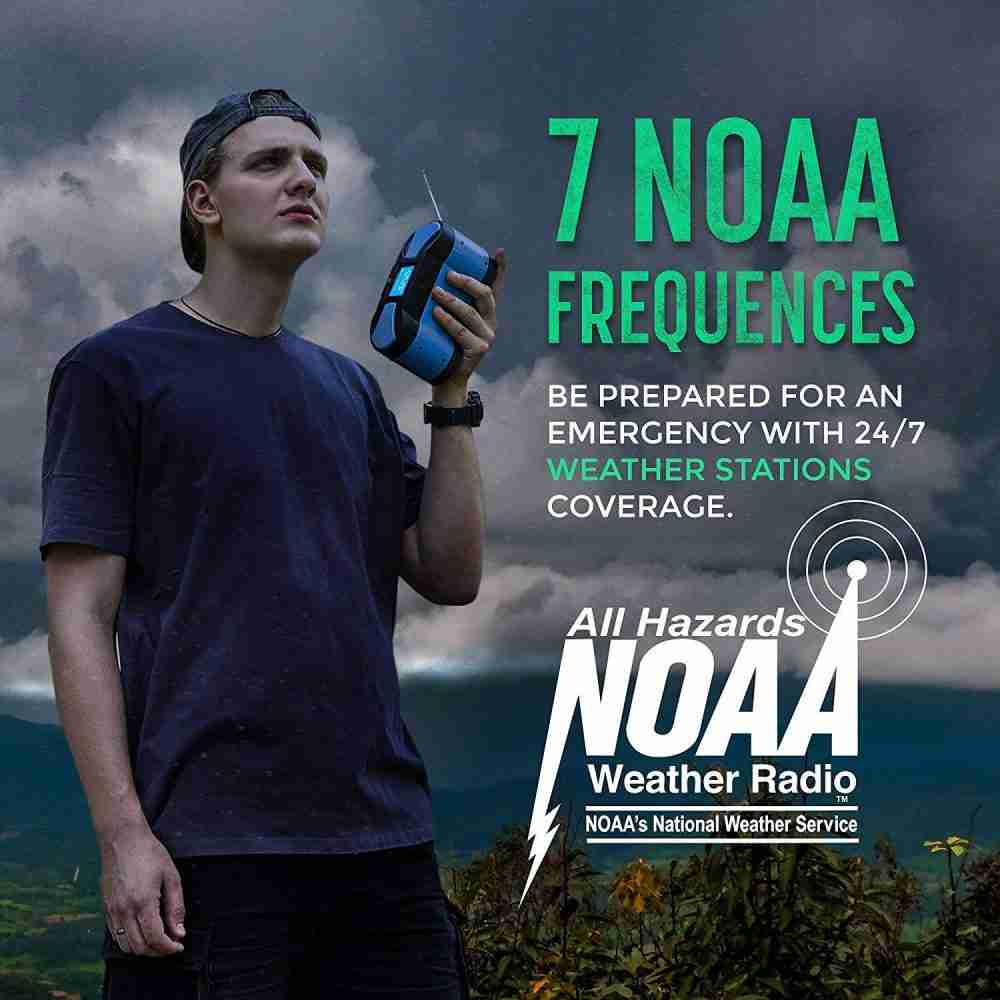Looking for a reliable, all-in-one outdoor weather sensor to give us accurate temperature, humidity, wind and rain data for our home or garden?
Product Overview: What the AcuRite Iris (5-in-1) Does for Us
We find that the AcuRite Iris (5-in-1) Weather Sensor with Rain Gauge, Wind Speed, Wind Direction, Temperature and Humidity (06004M) aims to put five essential outdoor weather measurements into a single, wireless package. The unit transmits every 36 seconds on a 433 MHz wireless signal and claims a line-of-sight range up to 330 feet (100 meters), which should cover most yards, rooftops, and light-coverage installations.
We appreciate that it runs on four AA batteries (alkaline or lithium) so we don’t need any special power source, but we also note that batteries are not included. The sensor is designed to pair with AcuRite 5-in-1 compatible displays (sold separately), so the display is something we must plan to acquire if we want a full local readout.
What’s included and what’s not
We expect to receive the 5-in-1 outdoor sensor assembly as the primary component. The manufacturer typically ships the sensor only, without the console or batteries. This means we should budget for a compatible AcuRite 5-in-1 display and four AA batteries if we want immediate operation.
We should also check the product listing or manual for the exact contents because mounting hardware, mast clamps, or a small instruction booklet may or may not be included with specific retailers’ packages. If mounting parts are missing, a standard weather station mounting pole or bracket usually works fine.
AcuRite Iris (5-in-1) Weather Sensor with Rain Gauge, Wind Speed, Wind Direction, Temperature and Humidity (06004M)
$86.39 In Stock
Key Specifications at a Glance
We like having a concise specs table to reference quickly. Below is a breakdown based on the product details provided and typical characteristics of this type of sensor.
| Feature | Details |
|---|---|
| Product name | AcuRite Iris (5-in-1) Weather Sensor (06004M) |
| Measured parameters | Temperature, Humidity, Wind Speed, Wind Direction, Rain |
| Transmission interval | Every 36 seconds |
| Wireless frequency | 433 MHz |
| Max transmission range | Up to 330 ft (100 m) line-of-sight |
| Power | 4 × AA alkaline or lithium batteries (not included) |
| Display compatibility | Compatible with AcuRite 5-in-1 weather station displays (sold separately) |
| Typical mounting | Pole or mast mount (hardware may vary) |
| Use case | Home, garden, small property weather monitoring |
We find this table useful for quick decision-making, and it gives us the essentials we need to plan installation and compatibility with our existing gear. If we need deeper technical specs (specific measurement ranges or accuracy tolerances), the manufacturer’s manual or product page is the best place to look.
Design and Build: How It Feels and Holds Up
We feel that the AcuRite Iris has the familiar weather-station look: an integrated rain gauge, anemometer cups, and a wind vane in a single housing. The compact design reduces wiring and clutter and makes it easier to mount on a single mast compared to separate, modular sensors.
We note that weather sensors are exposed to the elements, and build materials and sealing are critical. While the product appears designed for outdoor use, routine maintenance such as keeping the rain scoop clear and ensuring the anemometer spins freely will keep the unit operating reliably over time.
Physical footprint and mounting considerations
The unit’s compact footprint helps when mounting on a small property or roof edge. We can usually fit it on a standard 1″–1.25″ pole or mast with simple clamp hardware.
We recommend mounting the sensor away from obstructions like walls, large trees, or buildings if possible. For accurate wind readings, elevating the unit above rooftop turbulence and placing it in an open area is ideal.
Installation and Setup: Step-by-Step Recommendations
We like to keep installation straightforward, and with this AcuRite sensor the steps are predictable: power with four AA batteries, mount it securely, and pair it to a compatible display. The 36-second transmission interval means the display updates fairly frequently without overly draining batteries.
We find it helpful to map out the display location and the sensor line-of-sight before mounting. Even though the stated range is up to 330 feet, real-world obstacles and RF interference can shorten that distance, so try to maintain as few obstructions as possible between the sensor and the display.
Mounting tips for best performance
We suggest mounting the sensor on a dedicated pole or mast, ideally 10–15 feet above ground for wind readings. If installing on a roof, ensure secure fasteners and weatherproofing around any penetrations.
We also recommend using a non-metallic mounting bracket when possible or ensuring the pole does not create signal blockage between the sensor and display. Periodically check that the anemometer bearings and wind vane move freely and that the rain funnel is free of debris.
Pairing with the display
Pairing normally involves inserting batteries into the sensor and placing the compatible AcuRite display in “search” or pairing mode. We should follow the display’s instructions for adding an external sensor, as models vary.
If pairing fails, try bringing the display within a few feet of the sensor to ensure proximity then re-initiate pairing. Once paired, move the display back to the desired location but keep an eye on signal strength.
Transmission and Range: Real-World Considerations
We appreciate the 433 MHz transmission at 36-second intervals because it balances update speed with battery life. The specified maximum range of 330 feet is line-of-sight and can be affected by walls, trees, and other RF sources.
We recommend testing the signal by mounting the sensor temporarily at the intended height and moving the display to its planned indoor spot to verify signal strength. If we encounter intermittent reception, relocating the display or the sensor slightly often resolves the issue.
Dealing with signal interference
Wireless signals can be impacted by other devices using similar frequencies, structural metal, and even dense foliage. If we experience dropouts, we suggest trying different display locations, removing potential RF sources nearby, or slightly repositioning the sensor mast.
We also advise checking that the batteries are fresh and properly seated since weak batteries can degrade transmission strength and frequency.
Power and Battery Life: How Long Will It Run?
Running on four AA alkaline or lithium batteries gives us flexibility, and lithium cells often outperform alkaline cells in cold conditions. Battery life depends heavily on the chosen battery type and environmental extremes; we typically expect months rather than weeks with normal update intervals.
We recommend using high-quality lithium AAs for colder climates because they maintain higher voltage at low temperatures and often extend overall life. Keeping spare batteries on hand helps during prolonged cold snaps or heavy measurement periods.
Tips to maximize battery life
We find that reducing unnecessary handling and ensuring secure contacts helps. Use fresh batteries before the weather season starts and check once per season for corrosion or leakage.
If we plan to be away for an extended period, it’s sensible to remove batteries to avoid leakage damage. Also, avoid mixing old and new batteries and the two chemistries (alkaline and lithium) in the same pack.
Measurement Performance: Temperature, Humidity, Wind and Rain
We appreciate the convenience of a single device measuring five parameters. Accurate readings depend on sensor placement and maintenance — for example, radiation shielding improves temperature accuracy, and level rain gauges improve rainfall totals.
The daily practicality is strong: we can monitor precipitation totals, wind gusts for gardening or wildlife management, and microclimate temperature/humidity for plant care or comfort decisions.
Temperature and humidity accuracy
While AcuRite markets the sensor as high-precision, environmental sensors are subject to local microclimates. Placing the sensor in direct sun without shielding can skew temperature readings upward. We recommend mounting it in a location with good airflow and, where possible, using passive radiation shields or mounting in a shaded area to reduce solar heating bias.
Humidity sensors can drift over time if exposed to dust or salt spray. Keeping the sensor clean and protected from direct spray will improve longevity and the accuracy of humidity readings.
Wind speed and direction reliability
The integrated anemometer and vane are convenient but can be sensitive to mechanical wear. We recommend periodic checks to ensure the cups spin freely and the vane moves without friction. For gust measurements, elevated placement in open terrain gives the most representative data for the area.
Rain gauge performance and maintenance
The rain gauge likely uses a tipping bucket or similar mechanism to count rainfall increments. Keeping the funnel and tipping mechanism free of leaves, insect nests, or debris is essential; even small obstructions can cause undercounts or sticking. We recommend checking and cleaning the rain scoop monthly during rainy seasons.
Compatibility and Displays: What We Need to Use the Sensor
We must pair the sensor with a compatible AcuRite 5-in-1 weather station display, which is sold separately. Different AcuRite display models provide varying levels of detail, logging, and connectivity (some offer Wi-Fi/cloud options).
We recommend verifying that the specific AcuRite display we own or plan to purchase explicitly lists compatibility with AcuRite 5-in-1 sensors. The manufacturer’s product page or manual is the best source for a definitive compatibility list.
Display features to consider
We like displays that show multiple metrics at once and offer trend/history screens. If we want remote access or long-term logs, consider an AcuRite display with internet/cloud connectivity (if available) or a local console that supports data logging.
Choose a display with a clear layout for wind, rain totals, and temperature/humidity readings if we plan to use the data for gardening or weather tracking.
Maintenance and Care: Keeping the Sensor Accurate
Routine maintenance is simple but important. Periodic cleaning of the rain funnel, checking for insect nests, ensuring free movement of the anemometer and vane, and replacing batteries as needed keeps the sensor providing reliable data.
We also recommend inspecting for cracked housing or worn seals that could let water into sensor electronics. If we find damage, stop using the unit until it’s repaired or replaced to avoid inaccurate readings or further damage.
Seasonal maintenance checklist
We like to check the sensor at the start of each season: clean the rain funnel, lubricate bearings if manufacturer recommends (or gently free any sticky parts), test output by comparing to a reference such as a handheld wind meter or local official station, and replace batteries annually or as needed.
During winter, use lithium batteries to improve cold performance and watch for ice buildup on moving parts. In spring and summer, check for insect nests and wasp activity that can impede the rain funnel or the anemometer.
Troubleshooting Common Issues
We find most issues are simple to diagnose and fix if we follow a methodical approach: check batteries, verify pairing, inspect for physical blockage, and test signal strength close to the display.
If the display shows missing or inconsistent data, bring the display close to the sensor to confirm it’s transmitting, then move it back to the preferred location. If the sensor doesn’t transmit at all, reseat batteries and ensure contacts are clean.
Specific fault scenarios and fixes
- Sensor not pairing: Move the display within a few feet of the sensor, replace with fresh batteries, then try pairing again. If that fails, consult the display manual for clearing sensor lists or resetting both devices.
- Wind readings stuck at zero: Check the anemometer cups for obstructions, spin them by hand to check bearings, and clear any debris or cobwebs.
- Rain totals inconsistent: Level the sensor (a tilted rain gauge underreports), clean the funnel and tipping mechanism, and ensure no insects or leaves block the gauge.
- Weak signal or intermittent updates: Confirm line-of-sight, remove nearby metallic obstructions, and verify there’s no new source of RF interference in the home.
Comparisons: How This Sensor Stacks Up to Alternatives
We find that the AcuRite Iris 5-in-1 targets value-seeking consumers and homeowners who want a compact, integrated solution without professional-grade pricing. Compared to high-end, broadcast-capable systems (like professional meteorological stations), it’s simpler, more affordable, and easier to install.
Against similarly priced competitors, the main differentiators are brand ecosystem (AcuRite displays and cloud options), the 36-second update interval, and the single-unit convenience. For serious enthusiasts or agricultural applications, more robust hardware with professional calibration (and often higher cost) may be preferable.
When to choose this sensor vs. other systems
We recommend the AcuRite Iris 5-in-1 if we want an affordable, user-friendly weather sensor to monitor backyard weather, garden conditions, and local wind/rain events. If we need highly calibrated, research-grade data or professional logging and telemetry, consider higher-end stations that offer serial or cloud-based raw-data export and weatherproofed, serviceable components.
Pros and Cons: Quick Decision Guide
We like clear pros and cons to help make decisions quickly. Below are the main strengths and limitations we see.
Pros:
- Integrated five-sensor package reduces complexity and clutter.
- Regular 36-second updates give timely data for home uses.
- 433 MHz transmission and up to 330 ft range suit many properties.
- Uses standard AA batteries for easy replacement.
- Compatible with AcuRite’s 5-in-1 display ecosystem for a consistent user experience.
Cons:
- Display sold separately, so total system cost is higher than the sensor price alone.
- Real-world transmission range can be much less than 330 ft in obstructed environments.
- Moving parts (anemometer and wind vane) require periodic maintenance.
- Rain gauge can clog or stick if not cleaned regularly.
- Not intended as a professional meteorological-grade instrument.
We find these trade-offs reasonable for the target user: homeowners and gardeners who want practical local weather data without professional-level expense.
Use Cases: Who Benefits Most from This Sensor
We think this unit is perfect for homeowners monitoring microclimates, gardeners tracking rainfall and humidity, hobbyist meteorologists, and anyone who needs local wind information for small drones, hobby kite flying, or outdoor activities. Small property owners who need a simple, all-in-one sensor will appreciate the convenience.
We do not recommend this as the sole device for weather-critical professional operations that require certified accuracy and redundancy. For most personal and backyard uses, though, it hits the right balance of functionality and cost.
Examples of practical applications
- Gardeners who want to know exactly when soil will need watering based on rain totals and humidity.
- Weekend pilots or drone enthusiasts who use wind speed and direction to plan safe flights.
- Homeowners monitoring storms and local rainfall to manage runoff or small-property drainage.
- Schools or clubs conducting basic local weather education and data logging for simple projects.
Price and Value: Is It Worth Buying?
We assess value by weighing the sensor’s convenience and accuracy for home use against the cost of additional components (display and batteries). If the sensor price is reasonable relative to other 5-in-1 packages and the display is acceptable in price and features, the bundled ecosystem provides good value.
We advise comparing total cost (sensor + display) and features like remote access, logging, and alerts. If remote monitoring via the internet is required, ensure the chosen AcuRite display supports that or consider a system with native cloud connectivity.
Frequently Asked Questions (FAQs)
We often get similar questions, so here are practical answers based on common issues and setup concerns.
Q: Do we need the AcuRite display to use this sensor? A: Yes — the sensor transmits to AcuRite-compatible displays. The display is sold separately, so we must obtain a compatible display to view the sensor data locally.
Q: How accurate are the readings? A: The unit is marketed as high-precision for home use. Accuracy depends on placement, maintenance, and local conditions. For certified meteorological accuracy, a professional-grade station is required.
Q: How often does the sensor send data? A: The sensor transmits every 36 seconds, providing timely updates without excessive battery drain.
Q: Can we extend the wireless range? A: Range is primarily physical and RF-limited. If we need farther coverage, try repositioning the display or adding an intermediate receiver if AcuRite offers one; otherwise consider a display closer to the sensor or a different product with greater range or wired telemetry.
Q: What batteries should we use? A: We recommend high-quality lithium AA cells for better cold-weather performance and longer life. Alkaline batteries are acceptable in moderate climates.
Final Thoughts and Recommendation
We believe the AcuRite Iris (5-in-1) Weather Sensor (06004M) is a sensible choice for homeowners and hobbyists seeking a compact, relatively accurate, and easy-to-install outdoor weather sensor package. It packs temperature, humidity, wind speed, wind direction, and rain measurement into a single unit and transmits frequently enough for practical local use.
We recommend this sensor for anyone who wants a reliable backyard weather station and is willing to add the compatible AcuRite display. If we want professional-grade accuracy, higher durability, or advanced logging features, we should consider higher-end alternatives. For most of our day-to-day home-weather monitoring needs, however, this unit offers strong convenience and value.
Disclosure: As an Amazon Associate, I earn from qualifying purchases.


